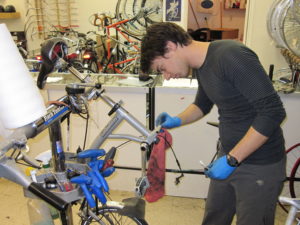This corporate confession based on the 10 Commandments is built upon the work of Pastor Eric Tonjes’ “Responsive Confession – The Ten Commandments.” The Leader portions all the same, as Eric leveraged the 10 Commandments. My additions primarily add specific corporate sins, past and present, to the confession, along with a few edits for simplification, and an assurance of forgiveness at the end. My additions are specific to the United States in 2025 and The Wesleyan Church.
LEADER: You are the Lord our God, who has led us out of slavery and made us a people for Your name. Father, you command us to have no other gods before you.
ALL: We worship created things. We worship pleasures. We worship money and reputation and power. We worship ourselves. Like some of the founding fathers, we hold our constitutional liberties higher than freedom from sin in Christ.
LEADER: You command us not to make or worship graven images.
ALL: We make gods of things that are not gods. We remake You, the one true God, in our image, as we idolize people. We do not worship You in the ways you require, and we worship in ways You do not require, so we can cover our sinful acts as enlightened tolerance.
LEADER: You command us not to use your name for vanity.
ALL: We abuse your name in anger, selfishness, and pride. We attach your name to things that are not worthy of it. We use it for profit, for hypocrisy, and to justify self-righteousness rather than resting in Christ’s righteousness. We have called ourselves a Christian nation and the new Isreal, We now call ourselves Christian Nationalists or Christian Progressives instead of just being Christ’s.
LEADER: You command us to remember the Sabbath and keep it holy.
ALL: Instead of trusting, we worry. Instead of seeking You, we strive. Instead of worshipping, our hearts are distracted. Instead of healing, we make pious excuses. We prefer idleness and doom scrolling to rest.
LEADER: You command us to honor our parents and those in authority over us.
ALL: We do not honor them but criticize them. We would rather be honored than to give honor. When we are given honor, we are puffed up in pride instead of giving honor to You, the name above all names. We are a country founded on rebellion to a king. What authority you give us; we use selfishly instead of honoring You as our true King in heaven.
LEADER: You command us not to murder.
ALL: We do not act as image bearers nor do we respect Your image in us. We destroy those You love with our words. Through our actions and inaction, we participate in and support systems that bring death to souls and to bodies.
Slavery was part of the foundations of our country. Now we imprison more people than any other country, and imprison and execute ethnic minorities at a disproportionately higher rate.
The African Methodist Episcopal Church was founded because black Christians experienced racism and segregation in the Methodist Church. The Wesleyan Church worked to end slavery, and give women the right to vote, but did nothing in the Civil Rights Movement.
LEADER: You command us not to commit adultery.
ALL: We call love that which is not love and fail to love in truth. We lust in our hearts and sin with our bodies. We objectify, use, and demean ones precious in Your sight. We created the internet as a tool for education and communication, and we use it to distribute pornography.
LEADER: You command us not to steal.
ALL: We rob our neighbors, locally and globally, of resources and reputation. We seek gain even when it is unjust. We live lives of hording and consumption. We support systems that benefit us even when they harm others.
LEADER: You command us not to bear false witness against our neighbors.
ALL: We lie for our egos, for our advantage, and because we hate the truth. We gossip, slander, and defame. Our words join with the devil in accusing and condemning rather than with Your Spirit of grace. We present only our best or filtered selves and our unchecked opinions on social media.
LEADER: You command us not to covet.
ALL: We are constantly discontent with what we have. We measure ourselves against our neighbors, begrudging their successes and rejoicing in their failures. We are ungrateful. At the same time we criminalize and shame homelessness.
LEADER: Lord, in Your mercy, forgive us our sins and restore our fellowship, for we know Your love, poured out in the blood of Jesus, covers a multitude of sins. Let us never be so proud that we think we cannot fall. Give us the strength of the Holy Spirit to walk in true repentance.








 My perception now is that public libraries have less books and less open hours, but more community events (such as children’s reading times) and more computers. (I remember the days of the card catalog.) With these changes, whether real or just perceived, I asked myself if the public system is failing or just changing. To answer that we need to know what is the purpose of the public library.
My perception now is that public libraries have less books and less open hours, but more community events (such as children’s reading times) and more computers. (I remember the days of the card catalog.) With these changes, whether real or just perceived, I asked myself if the public system is failing or just changing. To answer that we need to know what is the purpose of the public library. information, internet connected computers are a necessity. The Saint Paul library system provides reading times in multiple languages, not to enable people to avoid learning English, but to enable people of all ages to learn.
information, internet connected computers are a necessity. The Saint Paul library system provides reading times in multiple languages, not to enable people to avoid learning English, but to enable people of all ages to learn. We must ensure we have the correct mission, and methods have to adapt over time in order to continually fulfill the mission, even though that may mean for me a father that I have to buy my daughter her own books. Thus, the old ways are not necessarily thrown out, but they may be moved. The mission of The Church is to: love God, love others, make disciples, and heal (Matthew 22:36-40; 28:16-2, Luke 10:8-9, 2 Corinthians 5:18). I think we can all agree on that, so the question we have to face is not: What is my favorite way of accomplishing this mission?, but What is the best way?
We must ensure we have the correct mission, and methods have to adapt over time in order to continually fulfill the mission, even though that may mean for me a father that I have to buy my daughter her own books. Thus, the old ways are not necessarily thrown out, but they may be moved. The mission of The Church is to: love God, love others, make disciples, and heal (Matthew 22:36-40; 28:16-2, Luke 10:8-9, 2 Corinthians 5:18). I think we can all agree on that, so the question we have to face is not: What is my favorite way of accomplishing this mission?, but What is the best way? Lift up a song for Him who rides through the deserts, Whose name is the LORD, a father of the fatherless. God makes a home for the lonely; He leads out the prisoners into prosperity. Look at the birds of the air, that they do not sow, nor reap nor gather into barns, and yet your heavenly Father feeds them. Are you not worth much more than they? If you then, being evil, know how to give good gifts to your children, how much more will your Father who is in heaven give what is good to those who ask Him! (Psalm 68:4-6, Matthew 6:26; 7:11)
Lift up a song for Him who rides through the deserts, Whose name is the LORD, a father of the fatherless. God makes a home for the lonely; He leads out the prisoners into prosperity. Look at the birds of the air, that they do not sow, nor reap nor gather into barns, and yet your heavenly Father feeds them. Are you not worth much more than they? If you then, being evil, know how to give good gifts to your children, how much more will your Father who is in heaven give what is good to those who ask Him! (Psalm 68:4-6, Matthew 6:26; 7:11) The oblate candidates spend 24 hours at the monastery for a final discernment retreat. We spent much of our time either in silence or prayer, even taking our meals separately from the monastic community, but still participating in all the chapel prayer times.
The oblate candidates spend 24 hours at the monastery for a final discernment retreat. We spent much of our time either in silence or prayer, even taking our meals separately from the monastic community, but still participating in all the chapel prayer times. According to Genesis 2:15, God offered work to humanity as part of the good creation. Work becomes more difficult in Genesis chapter 3, but the curse on the earth does not make work on the earth any less a holy task. So while in Religious Studies I learned to delineate
According to Genesis 2:15, God offered work to humanity as part of the good creation. Work becomes more difficult in Genesis chapter 3, but the curse on the earth does not make work on the earth any less a holy task. So while in Religious Studies I learned to delineate  Set Goals
Set Goals Have Community
Have Community Form Relationships
Form Relationships Limit Time
Limit Time Use Symbols
Use Symbols